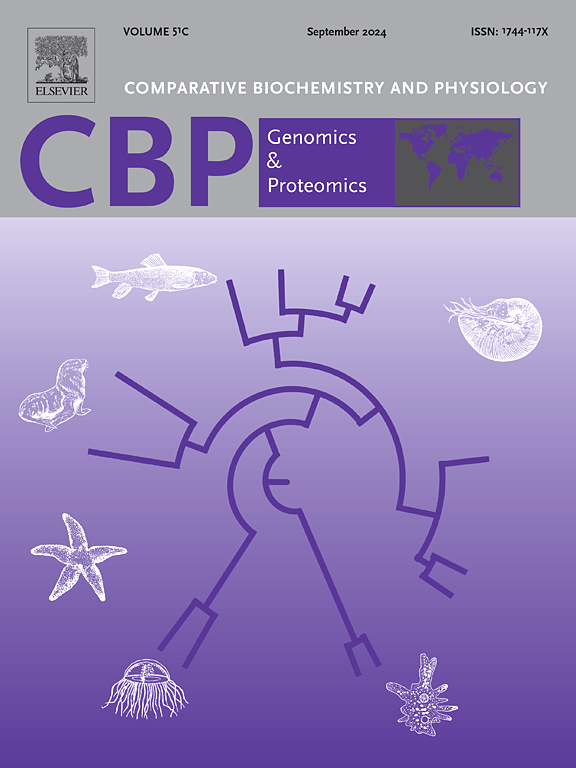Impact of triclocarban exposure on development and gene expression in the wolf spider, Pardosa pseudoannulata (Araneae: Lycosidae)
IF 2.2
2区 生物学
Q4 BIOCHEMISTRY & MOLECULAR BIOLOGY
Comparative Biochemistry and Physiology D-Genomics & Proteomics
Pub Date : 2025-01-10
DOI:10.1016/j.cbd.2025.101413
引用次数: 0
Abstract
Triclocarban (TCC), an emerging organic contaminant, poses a potential threat to water resources and ecosystems. The wolf spider Pardosa pseudoannulata (Araneae: Lycosidae) is a dominant predator typically inhabiting rice fields or wet habitats near water sources. However, little is known about the effects of TCC on the wolf spiders. In the present study, using environmentally relevant concentrations, we systematically investigated the toxicity of TCC on the early life stages of P. pseudoannulata at both physiological and gene expression levels. Our results indicated that TCC exposure did not significantly affect the survival and development of spiderlings. Transcriptome analysis revealed that TCC stress significantly impacted drug metabolism, cell cycle and signal transduction pathways in spiderlings. Subsequently, qRT-PCR was used to verify the expression levels of genes associated with drug metabolism and cell process, and the results were consistent with the transcriptome. These findings enhance our understanding of the toxic mechanism and ecological risk of TCC on arthropods.

三氯卡班暴露对狼蛛发育和基因表达的影响。
三氯卡班(TCC)是一种新兴的有机污染物,对水资源和生态系统构成潜在威胁。狼蛛(蜘蛛目:狼蛛科)是一种优势捕食者,通常栖息在稻田或靠近水源的潮湿栖息地。然而,人们对TCC对狼蛛的影响知之甚少。在本研究中,我们使用环境相关浓度,系统地研究了TCC在生理和基因表达水平上对假环伪树生命早期的毒性。结果表明,TCC暴露对蜘蛛的生存发育没有显著影响。转录组分析显示,TCC胁迫显著影响了蜘蛛的药物代谢、细胞周期和信号转导途径。随后,我们利用qRT-PCR验证了药物代谢和细胞过程相关基因的表达水平,结果与转录组一致。这些发现增强了我们对TCC对节肢动物的毒性机制和生态风险的认识。
本文章由计算机程序翻译,如有差异,请以英文原文为准。
求助全文
约1分钟内获得全文
求助全文
来源期刊
CiteScore
5.10
自引率
3.30%
发文量
69
审稿时长
33 days
期刊介绍:
Comparative Biochemistry & Physiology (CBP) publishes papers in comparative, environmental and evolutionary physiology.
Part D: Genomics and Proteomics (CBPD), focuses on “omics” approaches to physiology, including comparative and functional genomics, metagenomics, transcriptomics, proteomics, metabolomics, and lipidomics. Most studies employ “omics” and/or system biology to test specific hypotheses about molecular and biochemical mechanisms underlying physiological responses to the environment. We encourage papers that address fundamental questions in comparative physiology and biochemistry rather than studies with a focus that is purely technical, methodological or descriptive in nature.

 求助内容:
求助内容: 应助结果提醒方式:
应助结果提醒方式:


